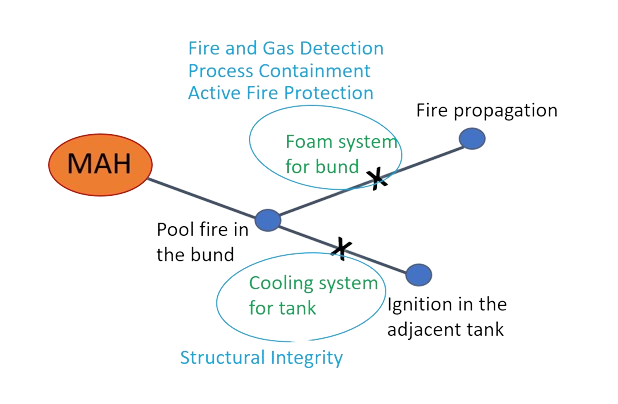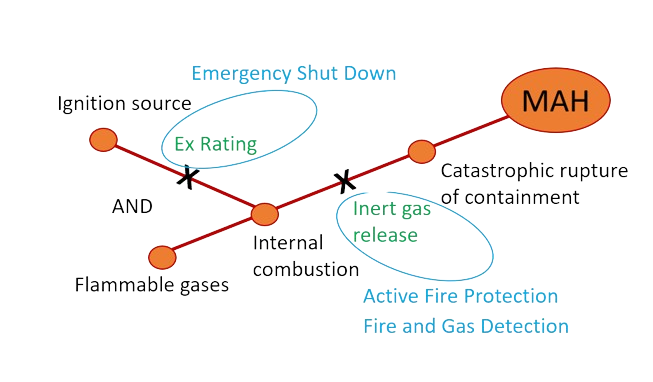IDENTIFYING SAFETY AND ENVIROMENTAL CRITICAL ELEMENTS (SECE)
The following steps as depicted are used for the identification of Safety and Environmental Critical Elements:
- Break the specific Power-to-X plant to the main systems and elements.
- Assess the criticality of each system by determining whether the failure of the system could cause a Major Accident hazard or contribute substantially to Major Accident Hazard scenarios. Any system found to be safety critical on this basis is deemed to be safety critical for reasons of integrity, i.e. if their integrity is maintained, then the Major Accident Hazard cannot occur.

Figure 8. SECE Identification - Right Hand Side
- For any system found not to be safety critical above, assess whether the system prevents or limits the consequences of a Major Accident Hazard. Any system or equipment item found to be safety critical on this basis is deemed to be safety critical for reasons of control and mitigation as an emergency response to a Major Accident Hazard.
- Once identified, the Safety and Environmental Critical Elements are categorized as follows:
o Integrity; and/or
o Control and mitigation.

Figure 9. SECE Identification - Left Hand Side
POWER-TO-X PLANT SECE
Following Safety and Environmental Critical Elements represents the minimum list for the Power-to-X plant:
SECE#1. Process shutdown and depressurization
- Emergency Shutdown
- Hazardous areas
- Blowdown
- Flare
SECE#2. Process containment and hazardous drains
- Isolation of inventories or dilution
- Leaks detection
- Disposal
SECE#3. Structural Integrity
- Explosion and fire protection
- Collapse resistance
- Overpressure protection
- Ventilation
- Passive fire protection
SECE#4. Active fire protection
- Process protection media selection and dimensioning
SECE#5. Fire and gas detection
- Detector type selection according to media and scenarios
- Interface with emergency shutdown, blowdown, and active fire protection
SECE#6. Escape, evacuation, and rescue
- Design equipment selection
- Survivability and escape
- Minimization of manning
POWER-TO-X PLANT DESIGN PHILOSOPHIES
Once the Power-to-X plant’s Safety and Environmental Safety Elements are identified the next step is to develop design philosophies and functional requirements for each Safety and Environmental Critical Element group. The philosophies, among others, may include (the list is not exhaustive):
- Overall Basis of Design
- Overall operating philosophy
- Design HSE philosophy
- Overpressure protection philosophy
- Fire engineering philosophy
- Emergency shutdown philosophy
- Integrated control and safety system philosophy
- Isolation philosophy
- Winterization philosophy
- and others.
DEVELOPING PERFORMANCE STANDARDS
Performance standards are those documents that lay the foundation for the expected performance from a Safety and Environmental Critical Element. A performance standard is typically defined as a set of requirements that constitute the basis for assurance tasks for safety-critical elements during the design (design performance standards) and operation (operation performance standards) of a Power-to-X plant. Hence it is essential to develop and identify performance standards for the identified Safety and Environmental Critical Elements during the engineering or design stage to conform to good engineering practices and reliable engineering.
For greenfield projects, it is extremely important that their design be robust and that they be able to perform their intended functions throughout their design life.
The recommended model for developing Safety and Environmental Critical Element design performance standard is based on the Functionality, Availability, Reliability, Survivability and Interaction (FARSI) format where:
- Functionality refers to the purpose that the Safety and Environmental Critical Element has to be able to perform to prevent, detect, or mitigate a hazardous event or to protect people.
- Availability refers to the proportion of the time that the Safety and Environmental Critical Element will be required to perform on demand.
- Reliability refers to how likely the Safety and Environmental Critical Element is to perform on demand.
- Survivability refers to how the Safety and Environmental Critical Element will perform after a major accident has occurred, i.e. how well it will survive a fire, explosion, etc.

